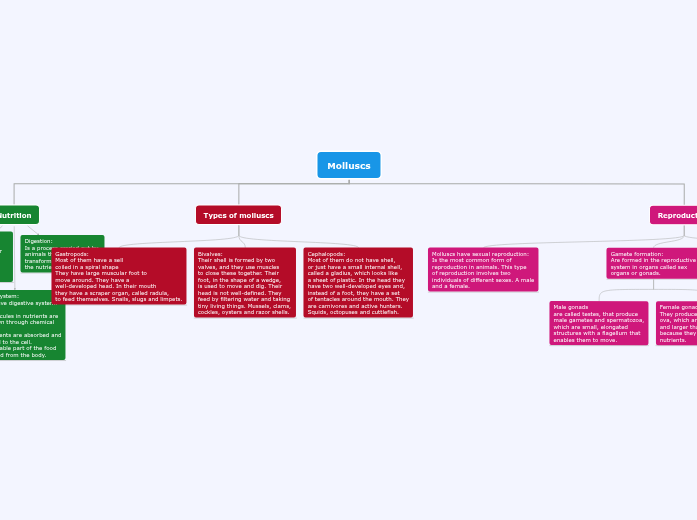Molluscs
Nutrition
Feeding:
Consists of taking food
that is material from other
living organisms that contains nutrients.
Molluscs obtain food by
the tentacles.
Digestion:
Is a process carried out by
animals that consists of
transforming food to obtain
the nutrients it contains.
Digestive System:
Molluscs have digestive system.
1-The molecules in nutrients are
broken down through chemical
processes.
2-The nutrients are absorbed and
transported to the cell.
3-The unusable part of the food
is eliminated from the body.
Digestive track:
Are long tubes with one
opening for taking in food
and another opening for
expelling undigested food.
They have specialised
parts for carrying out the
different processes involved
in digestion.
Types of molluscs
Gastropods:
Most of them have a sell
coiled in a spiral shape
They have large muscular foot to
move around. They have a
well-developed head. In their mouth
they have a scraper organ, called radula,
to feed themselves. Snails, slugs and limpets.
Bivalves:
Their shell is formed by two
valves, and they use muscles
to close these together. Their
foot, in the shape of a wedge,
is used to move and dig. Their
head is not well-defined. They
feed by filtering water and taking
tiny living things. Mussels, clams,
cockles, oysters and razor shells.
Cephalopods:
Most of them do not have shell,
or just have a small internal shell,
called a gladius, which looks like
a sheet of plastic. In the head they
have two well-developed eyes and,
instead of a foot, they have a set
of tentacles around the mouth. They
are carnivores and active hunters.
Squids, octopuses and cuttlefish.
Reproduction
Molluscs have sexual reproduction:
Is the most common form of
reproduction in animals. This type
of reproduction involves two
individuals of different sexes. A male
and a female.
Gamete formation:
Are formed in the reproductive
system in organs called sex
organs or gonads.
Male gonads
are called testes, that produce
male gametes and spermatozoa,
which are small, elongated
structures with a flagellum that
enables them to move.
Female gonads are called ovaries.
They produce feamle gametes or
ova, which are spherical, immobile
and larger than spermatozoa,
because they contain stores of
nutrients.
Some molluscs are
unisexual and hermaphrodite.
Unisexual:
Are those in which individuals
have separate sexes. This means
that they are either male and female.
Like cephalopods and bivalves.
Hermaphrodite:
Are species in which all
individuals possess both
male and female sex organs.
Like gastropods.
